The age of artificial intelligence is truly here.
In 2023, we saw a series of monumental developments in the world of AI—from the launch of OpenAI’s GPT-4 to Google’s rollout of AI-powered search.
And after a year of such drastic technological changes, businesses of all sizes are wondering to what extent they should ride the AI wave.
Today, we’ll explore the most up-to-**** artificial intelligence stats to help you decide if it’s time for your business to embrace AI.
Most Important AI Statistics
- AI could add a staggering $25.6 trillion to the world’s economy (McKinsey, 2023)
- Two-thirds of jobs could be partially automated by AI. But many of these jobs will be complemented by AI, not substituted by it. (Goldman Sachs, 2023)
- In 2023, the global AI market size was close to $208 billion. By 2030, the market size is expected to reach nearly $2 trillion (Statista, 2023)
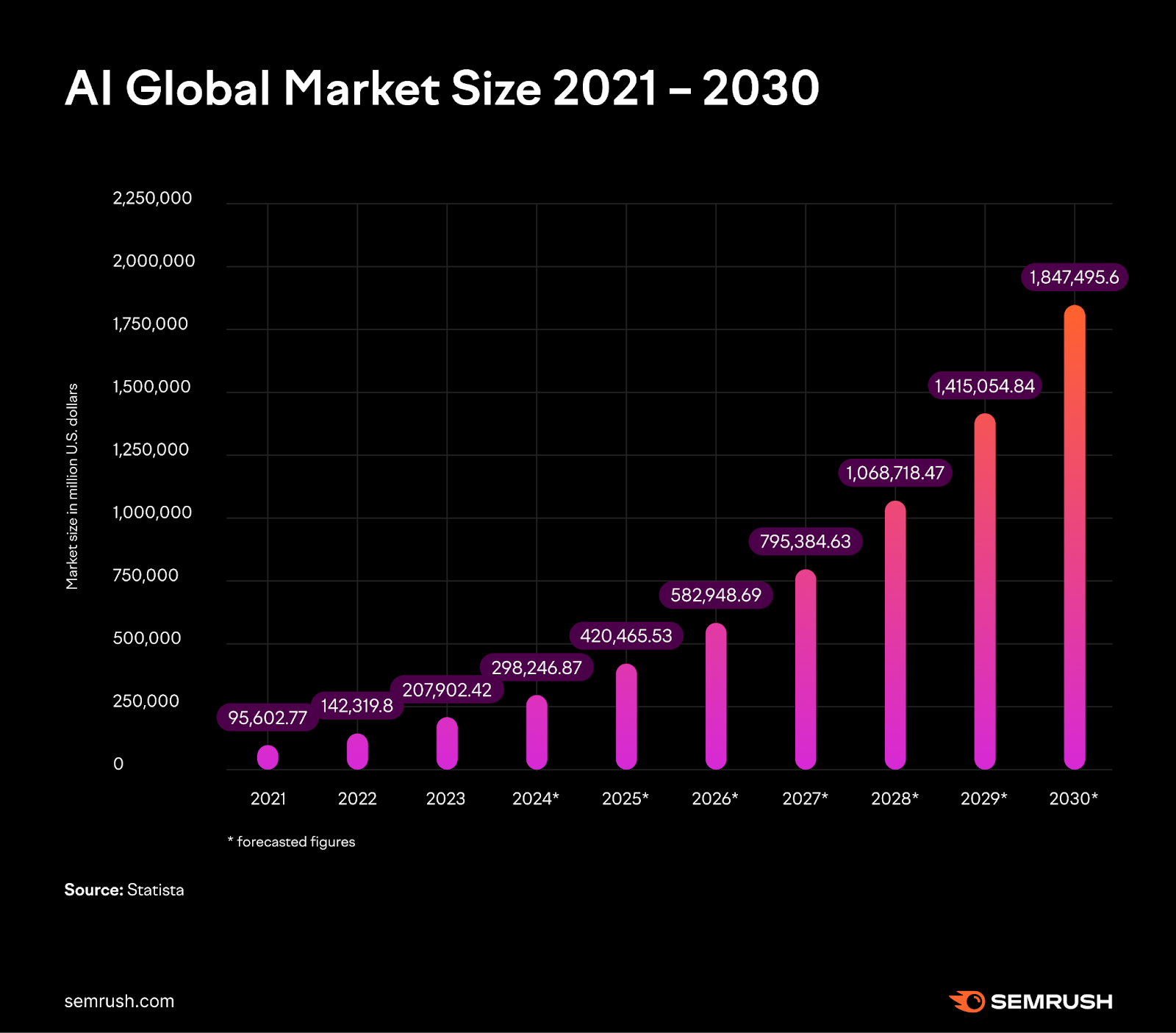
- In 2023, the global AI market was valued at $142.3 billion (Statista, 2023)
- Seventy-three percent of U.S. companies use AI in some aspect of their business (PwC, 2023)
- Over 25% of investments in American startups went to an AI-related company in 2023. By comparison, artificial intelligence startups received around 12% of total funding between 2018 and 2022. (Crunchbase, 2023)
- Following its release in November 2022, ChatGPT reached over a million users in five days and 100 million users within two months. This made it the fastest-growing consumer app ever at the time (a record since beaten by Facebook’s Threads app). (Statista, 2023)
- Fifty-four percent of companies had used generative AI in their business by November 2023—just one year since ChatGPT was released (PwC, 2023)
- OpenAI (the company behind ChatGPT) is seeking a valuation of up to $90 billion as of October 2023 (New York Post, 2023)
- Over 20% of generative AI users are 25- to 34-year-olds (Insider Intelligence. 2023)
Key Takeaways
These stats underscore that the rapid growth of the AI market is set to continue for the foreseeable future, potentially adding tens of trillions of dollars to the global economy.
AI adoption is already remarkably widespread among U.S. businesses. And although AI will likely impact most workers directly, it remains to be seen to what extent this new technology will augment or replace people’s jobs.
AI Statistics for Business
- Organizations estimate that 34% of all business-related tasks today are performed by machines (World Economic Forum, 2023)
- On average, businesses can expect a 6% to 10% revenue increase from adopting AI (Statista, 2023)
- AI could increase labor productivity growth by 1.5 percentage points over the next decade (Statista, 2023)
- Over 80% of Fortune 500 companies had adopted ChatGPT within their business by August 2023 (OpenAI, 2023)
- Forty-six percent of American companies have saved between $25,000 and $70,000 by using ChatGPT (Statista, 2023)
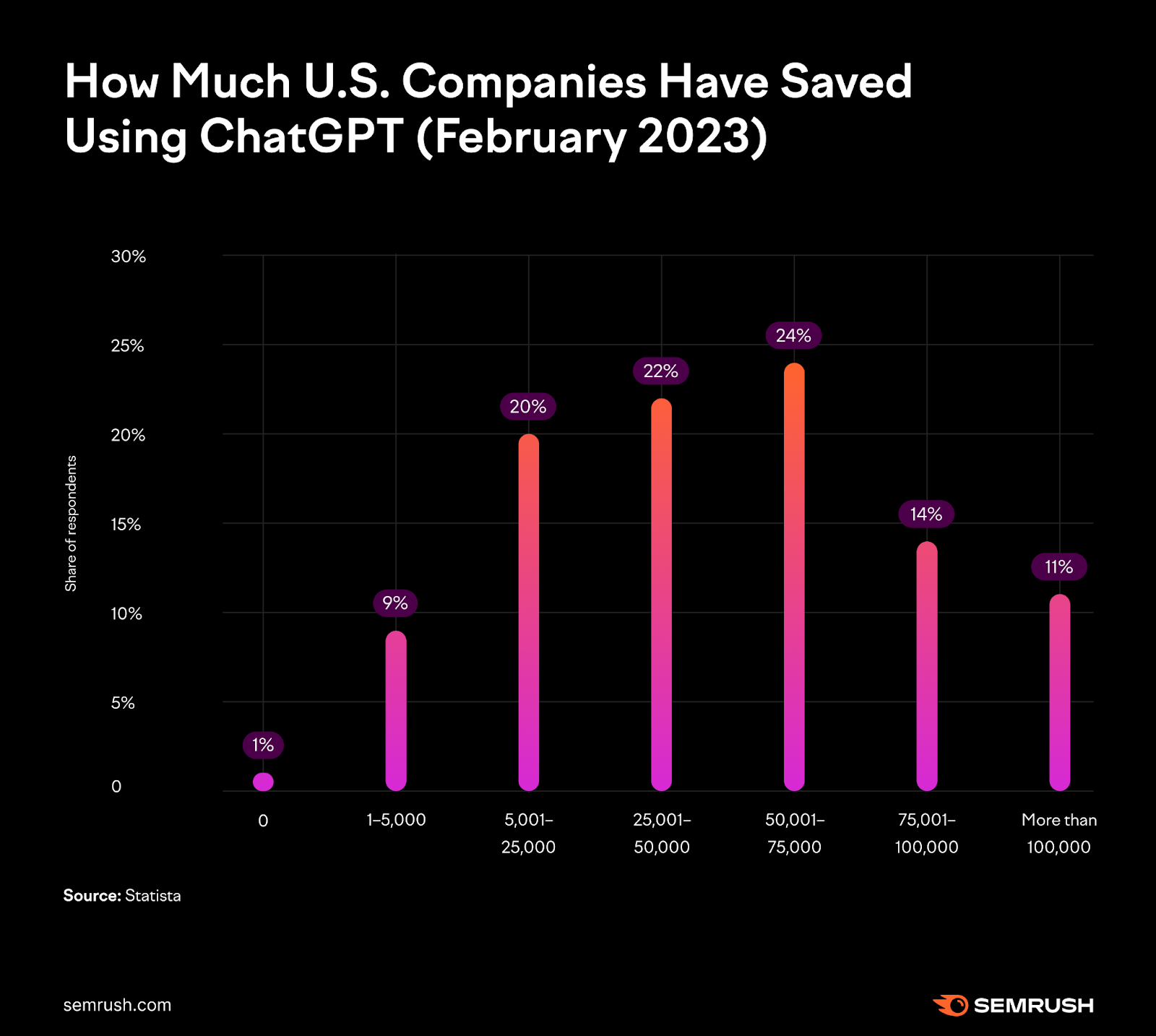
- In October 2023, 55% of organizations were piloting or implementing generative AI solutions (Gartner, 2023)
- In July 2023, 79% of corporate strategists said that technology like artificial intelligence would be critical to their success in the next two years (Gartner, 2023)
- Fifty percent of strategic planning and execution activities could be automated, according to strategists. Currently, only 15% of such activities are automated. (Gartner, 2023)
- The global market size for AI in manufacturing was $5 billion in 2023 and is forecast to reach $68 billion by 2032 (Precedence Research, 2023)
- The global market size for AI in telecommunication was $1.45 billion in 2022. It’s expected to grow at a compound annual growth rate of 28.2% from 2023 to 2030 (Grand View Research, 2023)
- The retail AI market is expected to grow at a compound annual growth rate of 30% from 2023 to 2030 (Global Market Insights, 2023)
- One-fifth of all industries use artificial intelligence across service operations and corporate finance (Statista, 2023)
- Over 30% of financial services companies use AI in product development (Statista, 2023)
- Automation in the education sector is expected to increase threefold with the use of AI (Statista, 2023)
- The market size for AI in security was $21 billion in 2023 and is forecast to reach over $50 billion by 2028 (Mordor Intelligence, 2023)
- The wearable AI market was valued at $20 billion in 2023 and is expected to reach $230 billion by 2033 (Fact MR, 2023)
Key Takeaways
These stats reveal how businesses across various industries have already adopted AI to enhance efficiency and increase profitability. AI is set to drive significant productivity gains over the coming years, leading to substantial market growth across a diverse range of sectors.
AI Adoption Statistics and the Job Market
- Existing AI technologies can automate tasks that absorb between 60% and 70% of workers’ time today (McKinsey, 2023)
- Around 80% of U.S. workers could have at least 10% of their work affected by generative AI. 19% of the workforce could see more than half of their work affected. (OpenAI, 2023)
- AI adoption could lead to at least 20% of enterprise employees needing to be reskilled (Statista, 2023)
- Data management positions are likely to see the biggest impact from AI. Around 90% of data processing positions and 80% of data collection positions will likely become automated due to generative AI. (Statista, 2023)
- At 78%, legal occupations are the U.S. jobs most influenced by generative AI (Forrester, 2023)
- Fifty-two percent of employed U.S. adults are concerned AI will replace their jobs (Mitre, 2023)
- Forty-seven percent of businesses consider using AI over hiring new employees (Tech.co, 2023)
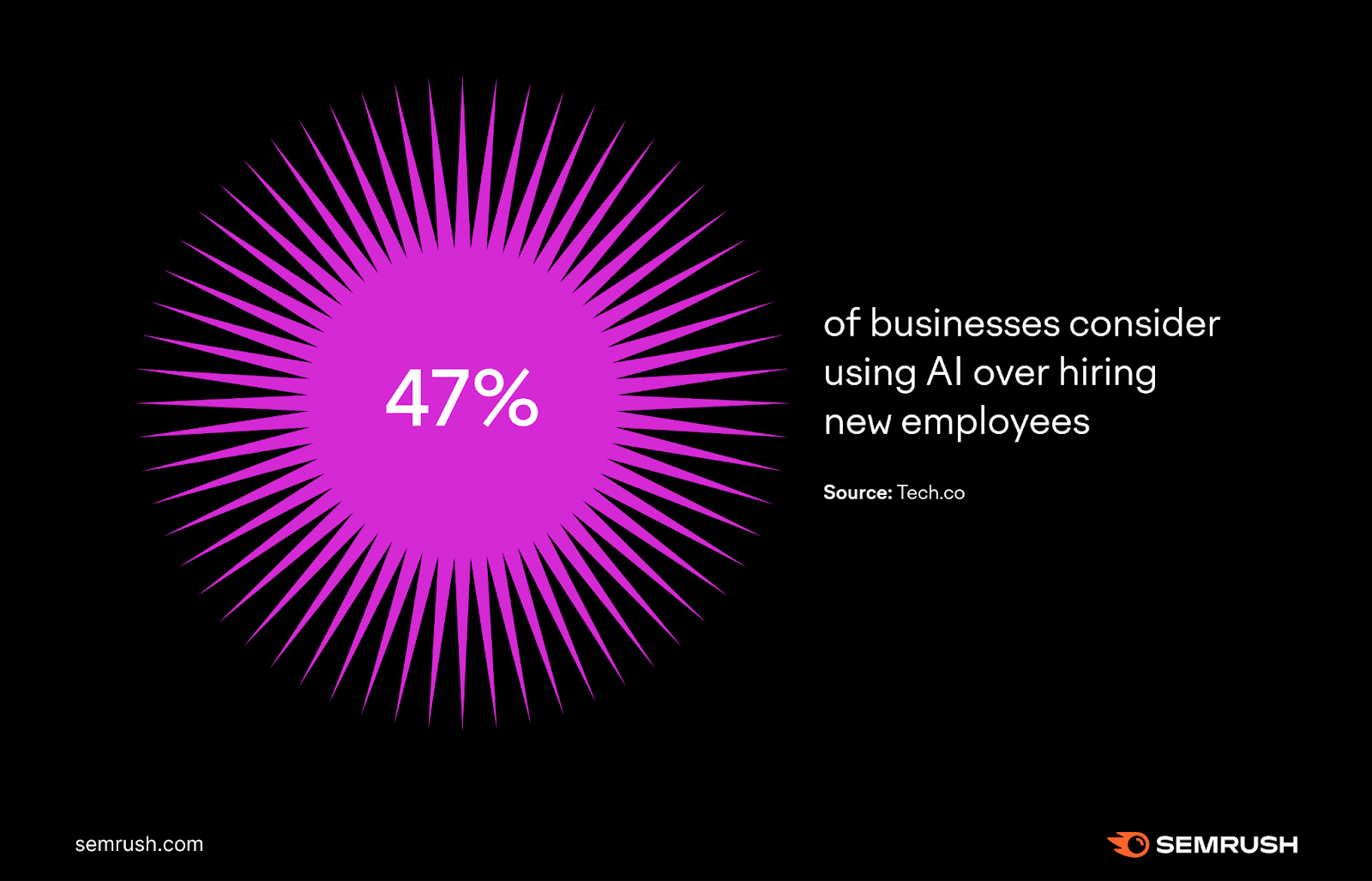
- One in three businesses could replace employees with AI in 2024 (Resume Builder, 2023)
- Ninety-six percent of companies hiring in 2024 say candidates with AI skills will be at an advantage (Resume Builder, 2023)
Key Takeaways
AI is already having a profound impact on the job market, with many companies preferring to adopt AI solutions over hiring new employees. This trend looks set to continue as AI technologies automate more and more human tasks. Many workers will be forced to retrain to adapt to the evolving job landscape, including acquiring new AI skills.
AI Marketing Statistics
- In 2023, 37% of people working in advertising or marketing in the U.S. had used AI at work (Statista, 2023)
- Fourteen percent of business leaders regularly use generative AI in marketing and sales (McKinsey, 2023)
- Sixty-seven percent of marketers believe that increasing the adoption of marketing automation is critical for acquiring and retaining customers (Mailchimp, 2023)
- Eighty-eight percent of marketers say they need to increase the use of automation and AI to meet customer expectations and stay competitive (Mailchimp, 2023)
- Almost 20% of marketing professionals have spent more than 40% of their marketing budget on AI-driven campaigns (Influencer Marketing Hub, 2023)
- Forty-four percent of businesses have used AI to write content (Influencer Marketing Hub, 2023)
Key Takeaways
AI is rapidly gaining traction in the marketing sector. Many marketers recognize AI’s value in streamlining customer acquisition, enhancing campaign effectiveness, and adapting to evolving customer expectations.
User Trust, AI Ethics, and Risk Management
- Only 39% of U.S. adults believe current AI technology is safe and secure (Mitre, 2023)
- Eighty-five percent of U.S. adults support a nationwide effort across government, industry, and academia to make artificial intelligence safe (Mitre, 2023)
- Eighty-percent of U.S. adults are concerned about AI being used for cyber attacks. And 78% are concerned about it being used for identity theft. (Mitre, 2023)
- Seventy-eight percent of business leaders think the benefits of artificial intelligence outweigh the risks (Gartner, 2023)
- Over one-third of organizations already use security tools to mitigate the risks of generative AI (Gartner, 2023)
- Fifty-six percent of companies say “inaccuracy” is the biggest risk posed by adopting generative AI. Yet only 32% of companies have systems in place for mitigating such inaccuracies. (McKinsey, 2023)
- Eighty-five percent of Americans want industry to share AI assurance practices before bringing AI-enabled products to market (Mitre, 2023)
- Almost 75% of corporate executives ranked AI ethics as important in 2021 (compared with less than 50% in 2018) (IBM, 2022)
- Fewer than 20% of executives firmly believe their applied AI ethics actually meet their stated values (IBM, 2022)
- Fifty-six percent of executives don’t know if their organizations have ethical standards in place for guiding the use of generative AI (Deloitte, 2023)
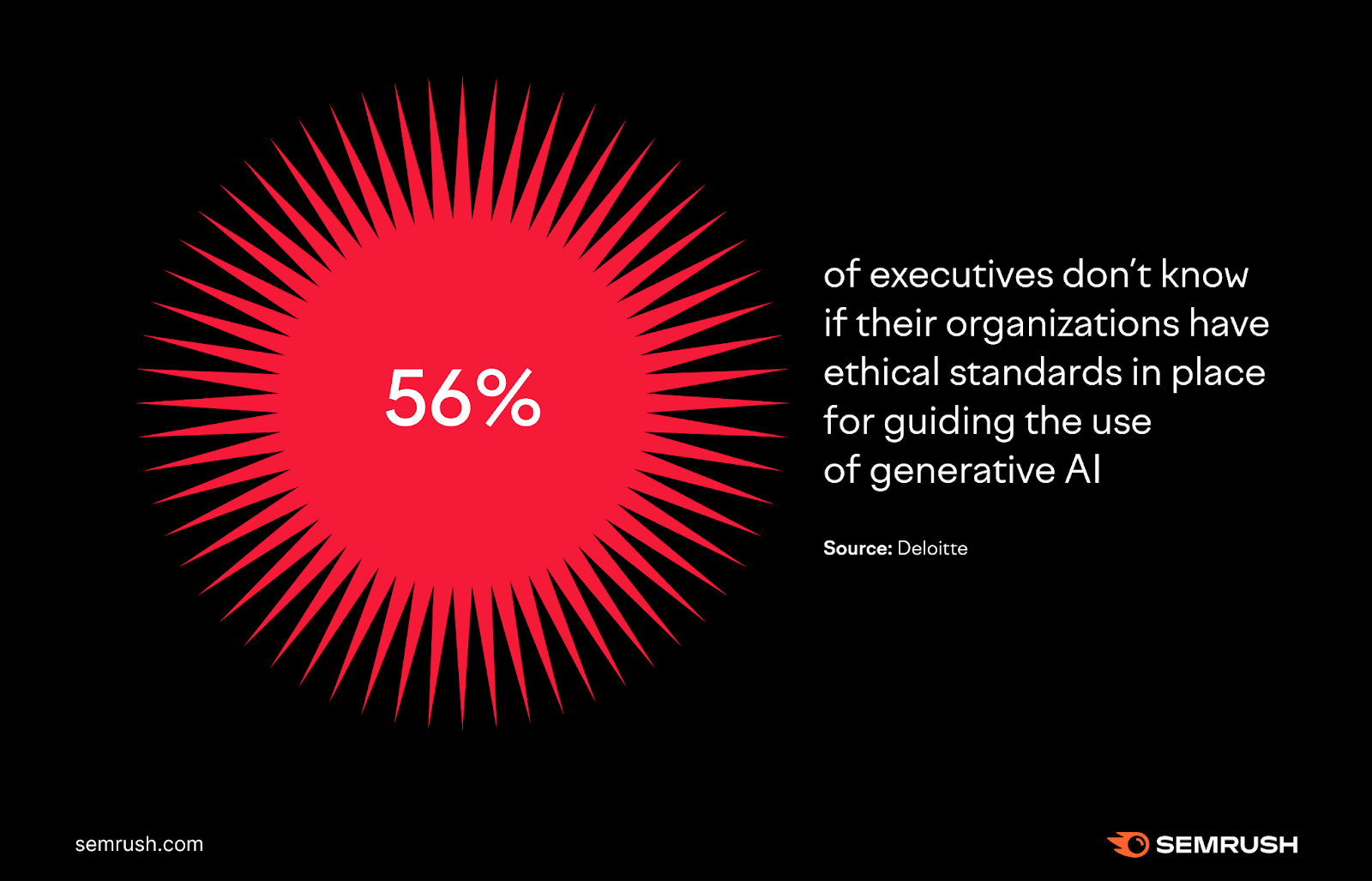
- Only 40% of people trust companies to be ethical in their use of new technology like AI (IBM, 2022)
- Twenty-two percent of executives cite data privacy as their top ethical concern about generative AI (Deloitte, 2023)
- Eighty-two percent of business leaders think it’s OK to use AI tools when responding to colleagues (Tech.co, 2023)
Key Takeaways
These stats highlight the mixed attitudes businesses and consumers have regarding AI risks. While there’s a clear demand for greater transparency and ethical standards in AI use, many organizations currently fall short of these expectations.
Artificial Intelligence Growth Statistics
- The global AI market is expected to exceed $1 trillion by 2028. That’s a growth factor of 40% each year from 2023 to 2028 (Statista, 2023)
- In 2023, the generative AI market size reached $44.89 billion globally and $16.19 billion in the U.S. (Statista, 2023)
- In 2023, the AI market size in the U.S. was $87.18 billion (Statista, 2023)
- The total global corporate investment in AI startups increased by $5 billion from 2020 to 2022 (Statista, 2023)
- The global corporate investment in AI reached almost $92 billion in 2022 (Statista, 2023)
- North America captured a 41% revenue share of the generative AI market in 2022 (Precedence Research, 2023)
Key Takeaways
Investment in AI technologies has skyrocketed in recent years, particularly in the U.S. And while the size of the global AI market is already measured in the tens of billions, it’s expected to break the trillion-dollar barrier toward the end of the decade. It looks like AI will transform the global economic landscape rapidly and profoundly.
Overview of Leading AI Technologies
- Generative AI could add $2.6 trillion to $4.4 trillion of value to the world economy each year (McKinsey, 2023)
- OpenAI is one of the most well-funded startups in history, securing over $12 billion in investments as of 2023 (Statista, 2023)
- The natural language processing (NLP) market is expected to exceed $112 billion by 2030 (Statista, 2023)
- There were 2.2 billion visits to ChatGPT in November 2023, 471 million of which were unique visits (Semrush data)
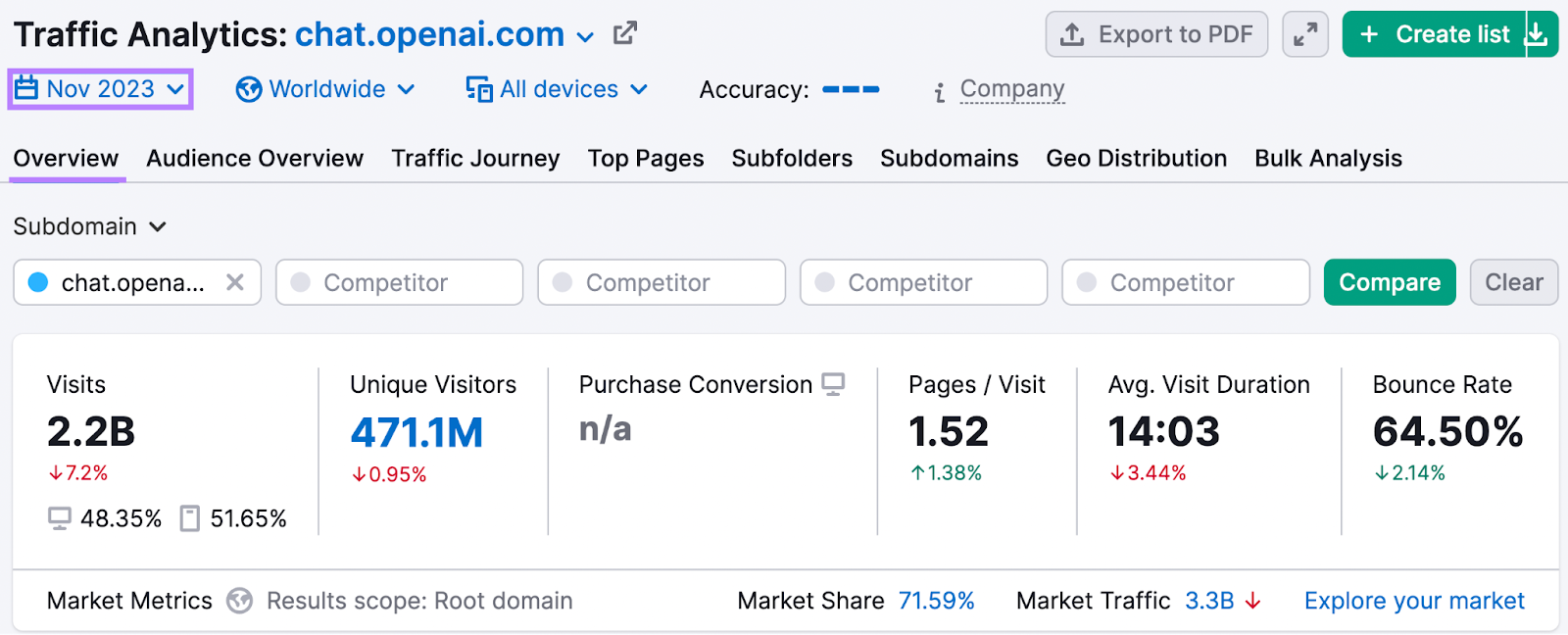
- In March 2023, Microsoft confirmed the new Bing was running on GPT-4 after much speculation (Bing, 2023)
- OpenAI currently supports access from 188 countries, regions, and territories (OpenAI, **** Not Specified)
- It’s estimated that ChatGPT costs up to $700,000 per day to run (Business Insider, 2023)
Key Takeaways
Generative AI has witnessed significant growth and investment in recent years. The dramatic success of OpenAI’s ChatGPT and its integration into various mainstream applications underscores the widespread impact and rising popularity of this new AI technology.
The Future of AI: Expert Predictions and Analysis
- Generative AI could lead to 0.1% to 0.6% annual growth in labor productivity through 2040 (McKinsey, 2023)
- AI could drive a 7% increase in global GDP (Goldman Sachs, 2023)
- China could see a 26% boost to GDP by 2030 thanks to AI (PwC, 2017)
- By 2030, generative AI could automate 30% of hours worked today (McKinsey, 2023)
- 300 million full-time jobs could become automated as a result of the new wave of AI systems (Goldman Sachs, 2023)
- AI could start to boost U.S. GDP in 2027 (Goldman Sachs, 2023)
- Global AI investment could reach $200 billion by 2025 (Goldman Sachs, 2023)
- The generative AI market size is expected to show an annual growth rate of 24.4% from 2023 to 2030, resulting in a market volume of $207 billion by 2030 (Statista, 2023)
- The global AI chip market is forecast to hit the $120 billion mark by 2027 (Statista, 2023)
- Global AI software revenues will reach $100 billion by 2025 (Omdia, **** Not Specified)
- Google expects its AI chatbot Bard will help it reach two billion users (Reuters, 2023)
Key Takeaways
The continued growth of AI technologies looks set to drastically increase global economic output over the coming decades. The widespread automation of human work-related activities may transform labor markets and unlock new efficiencies and innovation opportunities across industries.
Stay Ahead of Competitors in the AI Age
So, what do all these stats about artificial intelligence tell us?
First, there’s no doubt that AI has officially gone mainstream.
Most businesses (and consumers) now use it in one form or another. And according to the AI growth stats and predictions mentioned above, AI adoption will only accelerate over the next decade.
Of course, the expansion of AI technology isn’t without its downsides. We’ve seen that many people will be forced to reskill as increased automation disrupts the job market.
And there remain several open questions about how best to balance the use of this new technology with safety and ethical considerations.
That said, tools like AI Writing Assistant are set to unlock an unprecedented wave of productivity and efficiency across the world of business. As more and more routine tasks become automated, workers will have more time to dedicate to more creative and value-added activities.
Source link : Semrush.com
